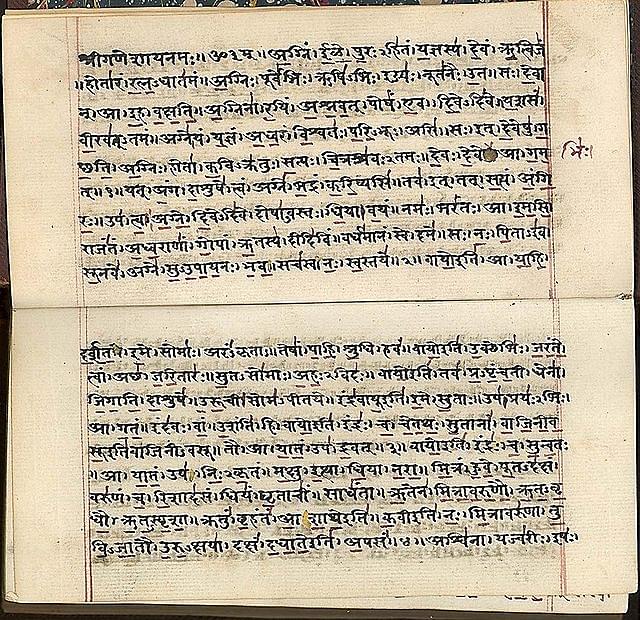Culture
Vedic Framework and Modern Science
Rajiv Malhotra
Nov 07, 2015, 11:20 PM | Updated Feb 11, 2016, 08:40 AM IST
Save & read from anywhere!
Bookmark stories for easy access on any device or the Swarajya app.

Rajiv Malhotra explains how to fit modern science into the Vedic framework.
A common desire among Hindus today is to see their Vedic tradition through the lens of modern science. There are good reasons for doing this. After all, modern science has accomplished so much and given us many gifts, thus attaining the status of being the gold standard of truth. Therefore, according to most persons, the legitimacy and worthiness of any body of knowledge should be determined by the extent to which it is in conformity with modern science.
I support this aspiration, but with some important caveats and qualifiers. Unfortunately, I do not see most scholars of what is being called ‘Vedic science’ appreciating these qualifiers. Hence, I wish to first explain some characteristics of Vedic knowledge, and then discuss the issue of how this knowledge relates to modern science. Let me start with what I do not wish for: I do not wish to have Vedic knowledge become digested into modern science. On the other hand, I actually want that the process be the opposite: I wish to fit modern science into the Vedic framework.
Vedic knowledge has two broad aspects: shruti and smriti. Shruti is that which is eternal, with no beginning or end. It is the absolute truth unfiltered by the human mind or context. Smriti, on the other hand, is knowledge as cognized by human conditioning. All modern science is smriti. This is the key insight I wish to offer and elaborate upon. Once we understand this and figure out its implications, we can easily see how modern science fits into the Vedic framework as a new type of smriti.
Because shruti transcends human conditioning, it is only available to the level of consciousness I have called the ‘rishi state’ in my book, Being Different. This is a state potentially available to every human being, and the various paths to achieving this are available in the Vedic system of knowledge and practices.
Everything that humans in the ordinary state develop, interpret and transmit is conditioned by the filters programmed into our minds; and hence it is smriti. Science is the understanding of reality based on human senses and reasoning, and hence is limited by these. All accounts of history are smriti. All political ideologies, including the constitutions of nations and the various laws of society are human constructions. All conceptual categories, vyavaharika (worldly) knowledge and experience are filtered through human conditioning. Every kind of knowledge being taught in the modern education system is limited to smriti because it consists of works produced by the human mind.
The relationship between shruti and smriti is very important to understand. These are not two disconnected realms. One can lead to the other: each path to attain the rishi state starts out in the vyavaharika realm, and each such path is based on smriti knowledge. Most forms of sadhana or spiritual practice we do are based on some smriti, and these have the potential to eventually lead us to the rishi state. Many texts used for yoga, bhakti, jnana and various other process are smritis. This is the relationship between absolute and relative knowledge, or between the transcendent and worldly realms.
Each epoch of history and every level of human consciousness had its own context in which knowledge has been generated and made available to us. Hence, we can think of shastra, itihasa and purana each as a certain genre or type of knowledge. Each is a smriti serving the purpose of informing certain kinds of minds, in ways suitable for such minds. Each genre of smriti is an approximation of shruti. As humans advance, they develop new needs and build new capabilities to fill those needs. Hence, new genres of smriti are always emerging as a result of human creativity.
Seen in this way, modern science is a special type of smriti developed for the logical mind, which is a mind that seeks truth by the criteria of such truth being reproducible and verifiable by anyone. This modern scientific truth has achieved great success in solving many kinds of practical problems. Instruments have been developed to measure and hence verify (or refute) empirical claims to ever finer levels of detail. Better measurements lead to more refined theoretical models, which in turn lead to better technologies. This is a cycle that feeds itself. It is undoubtedly one of the greatest achievements of humankind. Western civilization deserves credit for its successful pursuit of modern science.
Given this powerful new smriti called modern science, it might seem as if we can side line shruti. Alternatively, a naïve person might see it as desirable to map shruti knowledge onto modern science’s frameworks. I call this the bad habit of digesting one civilization into another. The problem is that modern science functions in terms of reference that block shruti altogether.
The Vedic framework has both shruti and many kinds of smritis in a coherent and organically unified system. However, trying to make shruti fit into the system of modern science is an unfortunate act of distortion and a digestion of shruti. The scientific framework is not rich and open enough to allow possibilities that are critical for the integrity of shruti. The reason for this problem is that modern science did not evolve as a smriti within the Vedic system.
Our challenge now is to map modern science into the Vedic structures so as to turn it into a smriti that would be compatible with shruti. This way, science would benefit from the Vedic vocabulary and framework; this would facilitate the further development of science.
For instance, the Vedic notion of shakti as ‘intelligent energy’ cannot be replaced by separate energy and intelligence being combined into a synthetic unity. Shakti is not two separate entities seen as one, but a single unified intelligence-energy entity. Also, shakti is not constrained by localization in the sense of classical science. Indeed, there is no substitute for shakti in modern science. It is a non-translatable. It includes multiple discoveries of modern science, such as: non-local causation; energy-matter equivalence; potential states of matter as a system of intelligence, etc. Yet, all these disparate modern ‘discoveries’ do not add up to shakti, for it is more than the sum of its parts. It is a blunder when Vedic scientists translate shakti into reductionist categories like ‘energy’, etc.
Similarly, the nature of time is very different in the Vedic framework than the notion of time in modern science. The principle of karma is a theory of delayed causation: Unlike physics where causation is only immediate and empirically traced back to the cause, in karma an action can have both immediate and delayed consequences, including consequences that are not empirically traceable to the cause. So karma theory would see physics as a subset, because it deals with immediate empirical effects only. In karma theory, the delayed portion of one’s actions are stored in potential form as a subtle form of causation memory (i.e. sanskaras) whose fruits emerge at a later time in some form.
Vedic scientists should stop the habit of mapping Vedic categories on to similar sounding modern scientific ones, because in doing so they are destroying humankind’s collective knowledge and blocking potential advancements. What Vedic scientists must do, instead, is to map modern science into Vedic categories, and investigate with open minds the feasibility of various such mappings. This includes both empirical testing and theoretical debates.
Do not translate akasha as space or ether. Rather, space/ether type of entities could be seen as a small subset of akasha. Fire is a subset of agni and its many forms. The fashionable term ‘energy healing’ (itself largely based on appropriating Vedic ideas) is a subset of the vast terrain we know as pranic healing. The list is endless.
There is another problem with rash translations of Vedic terms into modern science. Because science is smriti, it is in flux and will always be superseded by superior models as humans advance their vyavaharika knowledge. When that happens, the Vedic mappings to science will make the Vedic framework seem obsolete as well. For instance, Indians mapped akasha as ‘ether’ in the late 1800s, in order to make Vedic knowledge look ‘scientific’. A few decades later, physicists rejected the concept of ether. What did that do to the category of akasha? It became embarrassing as something that ‘science had proven to be false’. So it is better to let akasha remain akasha and resist the craving to impress modern scientists.
Whatever is non-translatable is also non-digestible. As long as we retain our framework and its categories, and utilize them actively in futuristic research, we will be able to protect the integrity of our tradition. This should be the basis for our identity; it is priceless.
The key research project for us is to identify principles and practices of Vedic knowledge that can be shown to be distinct from the conventional science of a given epoch. It has been shown that the mathematical idea of infinitesimal and infinite series was incompatible with Christianity’s worldview and was imported from India to Europe, leading to the ‘discoveries’ by Descartes, Newton and others.
Many Ayurveda principles are simply alien to Christianity as well as modern medical science because Ayurveda uses notions of physiology that Western medicine lacks. Hence, certain Indian diets that are becoming trendy in the West for medical benefits have been validated empirically by modern medicine, but the science behind these is still new in the West and is disconnected with core Western assumptions about the nature of the human being. Vedic principles of the environment are rapidly being assimilated for the sake of modern ecology; but the framework on which they are based is being separated out, the ‘useful elements’ isolated and grafted on to Western frameworks. As a result, the environment is now being protected more for the sake of ‘natural resource management’ than as a stakeholder in its own right. The single most promising area of Vedic knowledge for the future is in the vast realm of the mind sciences. This has been an ongoing research topic for me and one in which I intend to write extensively.
While most of the Vedic scientists have been negligent in doing purva-paksha to understand the digestion under way, the Western scientists have been frantically busy in their mining expedition to extract and digest Vedic knowledge. Many Vedic scientists, gurus and political leaders have foolishly been serving such enterprises, in the name of ‘becoming global’.
The Abrahamic religions are disconnected from both shruti and modern science. They do not allow the notion of the rishi state as a human potential. Therefore, what we call shruti is simply unavailable in their system. Humans, according to them, are inherently limited only to the smriti level of knowledge. To transcend this human limit of conditioning and context (i.e. to go beyond the smriti level), one has to receive messages from God sent through prophets. This is the only way by which humans can hope to know the higher truth that cannot be directly cognized by our limited minds. As a result of this, the history and texts of the lineage is all we have to know the higher truth. This is why the Abrahamic religions are stuck in past history and fight to death over minute details of that history. There are no rishis available to them to rediscover the higher truth, because the human potential does not include such higher states.
The Abrahamic religions have also never had an adequate framework for science. On the contrary, being history-centric has made them persecute free thinking. Hence, they cannot even allow new smritis based on new contexts and new human experiences.
Templeton Foundation has been pioneering on behalf of Judeo-Christianity to bridge the separate worlds of science and religion. It hijacked the project started by Infinity Foundation at the University of California started in the 1990s. This project was bringing into the academic world the dharma-based metaphysics of science and spirituality (vyavaharika and parmarthika, respectively). After Infinity Foundation had funded and provided intellectual inputs to this program for three years, Templeton learned about it and came with much larger funding offers to take over the project. The direction was changed and it switched over to becoming another one of its digestion projects. They recruited many Hindu thinkers, including some prominent ones that Infinity Foundation had nurtured for several years.
The above is only one of several examples where our intellectuals have been co-opted by those who want to impose their worldview; a worldview which is usually based on the western Judeo-Christian framework and propped up as the Universal. My point is that our intellectuals have lacked the vision to pursue research that would be in our best interests, and have aligned themselves with those trying to digest our heritage.
To sum up, I wish to leave the reader with the following key points:
- Modern science should be seen by us as a new kind of smriti, one that has a very useful purpose.
- Unfortunately, this new smriti has been built on a framework and vocabulary that is disconnected from the Vedic one, and hence it would be a good idea to express modern science in Vedic terms. This would allow us to develop modern science further because of the broader framework offered by the Vedas.
- Abrahamic religions are a form of smriti also, but very limited and primitive, because they do not believe in the human potential I have called the rishi state. This makes these religions historically frozen and dogmatic, vulnerable to violence.
- A serious blunder that is going on is the fashion to map shruti on to modern science (and even to Abrahamic religions). This must stop, and be reversed: We must do purva-paksha of modern science and the Abrahamic religions using our frameworks instead.
Save & read from anywhere!
Bookmark stories for easy access on any device or the Swarajya app.
Indian–American researcher, author, speaker. Current affairs, inter-civilization, science
Introducing ElectionsHQ + 50 Ground Reports Project
The 2024 elections might seem easy to guess, but there are some important questions that shouldn't be missed.
Do freebies still sway voters? Do people prioritise infrastructure when voting? How will Punjab vote?
The answers to these questions provide great insights into where we, as a country, are headed in the years to come.
Swarajya is starting a project with an aim to do 50 solid ground stories and a smart commentary service on WhatsApp, a one-of-a-kind. We'd love your support during this election season.
Click below to contribute.





